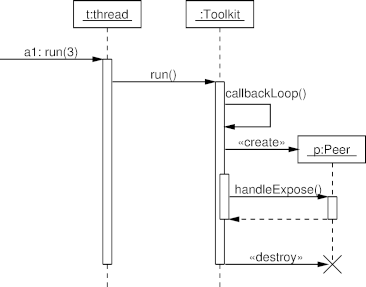Sequence Diagram Example: Nested Activation and Complex Interactions
The following diagram, based on the one appearing on p. 436 of the
UML User Guide, contains the most important elements
of an interaction.
It also uses nested
active inactive calls to show a nested object activation.
Diagram

Diagram Source Code
# UML User Guide: Appendix A,p. 436
.PS
copy "sequence.pic";
# Define the objects
pobject(E,"External Messages");
object(T,"t:thread");
object(O,":Toolkit");
pobject(P);
step();
# Message sequences
message(E,T,"a1: run(3)");
active(T);
message(T,O,"run()");
active(O);
message(O,O,"callbackLoop()");
cmessage(O,P,"p:Peer"," ");
active(O);
message(O,P,"handleExpose()");
active(P);
rmessage(P,O,"");
inactive(P);
inactive(O);
dmessage(O,P);
inactive(T);
inactive(O);
step();
complete(T);
complete(O);
.PE
 Last change: Tuesday, October 28, 2014 4:26 pm
Last change: Tuesday, October 28, 2014 4:26 pm
